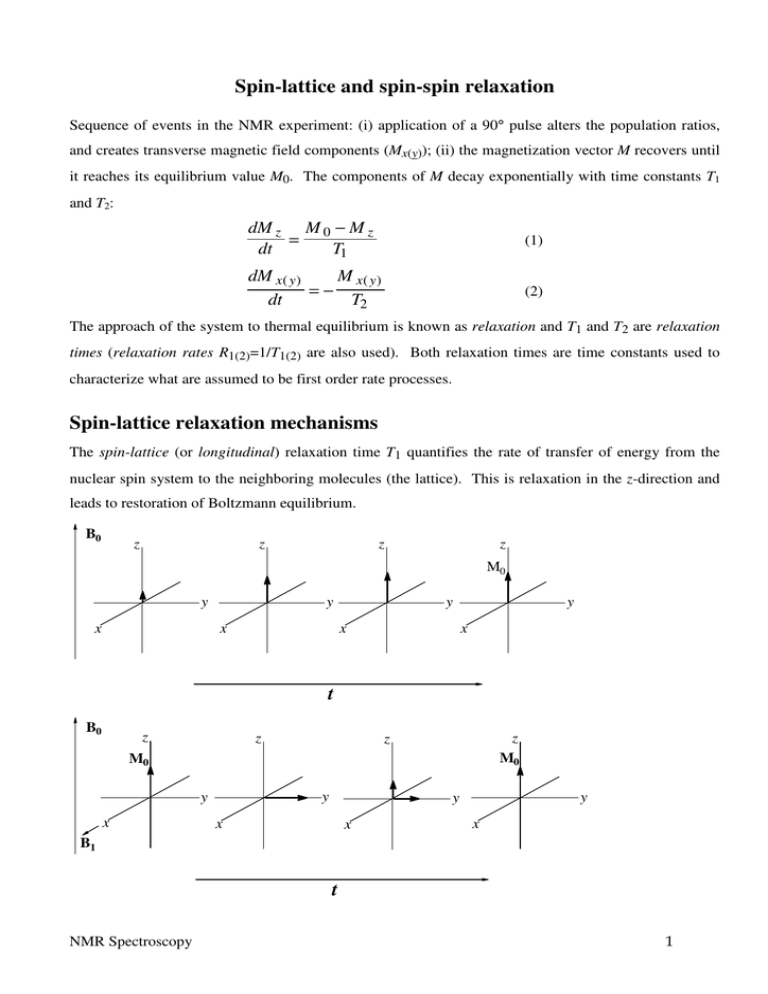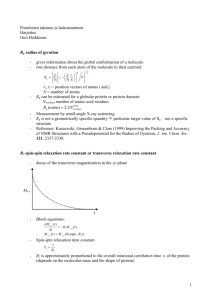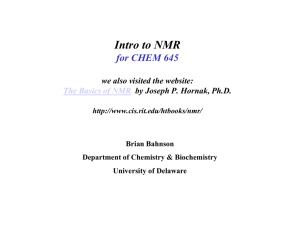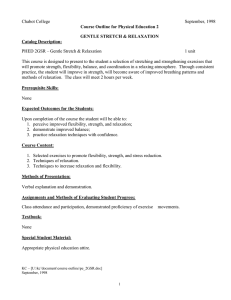Spin-lattice and spin-spin relaxation
advertisement

Spin-lattice and spin-spin relaxation
Sequence of events in the NMR experiment: (i) application of a 90° pulse alters the population ratios,
and creates transverse magnetic field components (Mx(y)); (ii) the magnetization vector M recovers until
it reaches its equilibrium value M0. The components of M decay exponentially with time constants T1
and T2:
dM z M 0 − M z
=
dt
T1
(1)
dM x( y )
M x( y )
=−
dt
T2
(2)
The approach of the system to thermal equilibrium is known as relaxation and T1 and T2 are relaxation
times (relaxation rates R1(2)=1/T1(2) are also used). Both relaxation times are time constants used to
characterize what are assumed to be first order rate processes.
Spin-lattice relaxation mechanisms
The spin-lattice (or longitudinal) relaxation time T1 quantifies the rate of transfer of energy from the
nuclear spin system to the neighboring molecules (the lattice). This is relaxation in the z-direction and
leads to restoration of Boltzmann equilibrium.
B0
z
z
z
z
M0
y
x
y
x
y
x
y
x
t
B0
z
z
z
M0
z
M0
y
y
x
y
y
x
x
x
B1
t
NMR Spectroscopy
1
⇒
Closely spaced energy levels
Excited nuclear
spins
the rate of spontaneous emission is negligible (~ 10-25 per second)
"LAT T ICE"
translations, rotations and
internal motions of molecules
∆E
For any given NMR transition, there will be some possible change within the lattice involving the same
quantity of energy.
A downward flip
An acceleration of some motion of the
⇒
of a nuclear spin
molecule in which the flip occurred
T1 values are relatively long due to the lack of means to transfer energies of NMR transitions into
thermal energy.
Requirements for the energy transfer:
(i)
the motion in the lattice (which is expected to gain or lose the energy from the nuclear spin
transition) must cause a fluctuating magnetic field (effectively acting as a “local pulse”) at
the site of the nuclear spin involved.
(ii)
as for the observe rf pulse, the local fluctuating field must have a component at the Larmor
frequency, ν0, of the nucleus under consideration.
(iii)
only x and y components of the local field can cause T1-relaxation.
B0
z
z
z
Bloc(t)
y
x
y
x
y
x
B1
The rf field B1 affects all the spins similarly and in a concerted way (i.e., the rf pulse is coherent).
The local field Bloc is randomly different at the site of each spin at any instant (i.e, the local field is
incoherent).
The most common source of the local fluctuating field for spin-1/2 nuclei is direct dipolar interaction.
NMR Spectroscopy
2
+
N
S
_
Electric dipole
Magnetic dipole
In single crystals:
B lo c
NA
S
B0
N
S B
N
S B
N
S A
B lo c
HA
r
HB
HA
HB
r
θ = 0
θ = 90
In solution the rapid reorientation of the dipolar interaction due to molecular motions provides
fluctuating fields. This relaxation mechanism depends on the rate of molecular motion. Thus, T1 is
temperature dependent.
Molecular dynamics
The correlation time τc − the time taken for the (spherical) molecule to rotate by roughly 1 radian. For
typical values of the viscosity in organic solvents:
τc ≈ 10-12 Mw
where Mw is the molecular mass (in Daltons).
In the solid state, where the motion is hindered, τc is large and there are only weak frequency
components near ω0 (= 2πν0):
ω0 τc >> 1
⇒
T1 is long
Rapid motion, associated with short τc, does not possess much intensity at ω0.
The extreme narrowing limit:
ω0 τc << 1
⇒
T1 is long
The frequency distribution is optimum for T1 relaxation in the intermediate region where 1/ τc ~ ω0:
ω0 τc ≈ 1
NMR Spectroscopy
⇒
T1 minimum
3
T1(2) / s
360 MHz
T1
60 MHz
T2
τc / s
Other mechanisms for spin-lattice relaxation:
(i) interaction with unpaired electrons (e.g., in paramagnetic substances). This can be very efficient and
can lead to featureless broad lines.
Sometimes it can be beneficial to add a small amount of
paramagnetic impurity if the relaxation times are very long.
(ii) interaction with electric field gradients for quadrupolar nuclei (with spin I > 1/2). This usually leads
to short relaxation times and often featureless broad lines are observed.
The spin-lattice relaxation time determiness what recycle delay between pulses should be used. The
nuclear spin system must be allowed to relax back to equilibrium before the next pulse is applied and
this time period is determined by T1.
NMR Spectroscopy
4
Relationship between T1 and chemical structure
The T1 values for 13C nuclei directly bonded to protons vary between 0.1 - 10 s. Longer values
(10 - 300 s) are observed for quaternary carbons. This is due to the fact that the main contribution to
T1-relaxation comes from 1H-13C dipole-dipole interactions. In the absence of the motional effects,
directly bonded protons have the largest effect on the T1 values of corresponding
13
C nuclei: the more
hydrogen atoms are attached to a carbon the shorter T1 is.
Isooctane
T1 / s
9.3
CH3
H3C
C
68
CH3
9.8
CH3
13
CH2
C
CH3
H
23
For the dipole-dipole relaxation, there is a strong dependence of the relaxation rate on the
distance between interacting nuclei T1-1 ~ rCH-6. In isooctane there are many spin-pairs to
consider in order to estimate the contribution of the 1H-13C dipole-dipole interaction and the
above relationship needs to be modified: T1-1 ~ ∑i rCH(i)-6. As a first approximation, we can
include into consideration only directly-bonded protons: T1(CH)/T1(CH2)=2.
This is in
agreement with the experimental values: 23/13=1.77. Possible reasons for the small deviation
from the predicted ratio are that the dipolar relaxation is additionally affected by more distant
protons [e.g., there are 8 and 1 geminal protons for the CH2 and CH groups, respectively, in
isooctane], and that relaxatiom mechanisms other than the dipole-dipole interaction may also be
present. In the case of the CH3 groups, T1 is greater than T1(CH)/3, showing that the methyl
rotation slows down considerably the 1H-13C dipole-dipole relaxation by shortening the effective
correlation time τC.
Dependence on the magnitude of the nuclear magnetic moment
Phenanthrene
1H 1H
2H 2H
59 s
80 s
µ(1H) / µ(2H) ≈ 4
NMR Spectroscopy
5
Spin-lattice relaxation time measurements
The standard method for measuring T1 is known as inversion-recovery. First, a 180°x inverts the
magnetization along the -z axis. A time period, τ, is allowed, during which spin-lattice relaxation occurs
causing Mz to go from the value of -M0 through zero to its equilibrium value of M0. A 90°x pulse is then
applied and the FID is recorded.
The experiment is repeated with different τ delays, allowing
determination of of the T1 value.
Quantitatively, the decay of Mz is given by the Bloch equation (1). Integration of Eq (1) with Mz = -M0
at t = 0 gives:
Mz = Mo [1 - 2 exp(–t/T1)]
In practice, the following equation is used:
ln (I∞ - Iτ) = ln 2I∞ - τ / T1
where Iτ is the initial intensity of the signal after the 90°x pulse at time τ, and I∞ is the limiting value of
Iτ for a very long interval τ. T1 is determined from the slope of a plot of ln (I∞ - Iτ) vs. τ.
For τ = T1 ln 2 = 0.69 T1 ⇒ Iτ = 0, i.e., T1 can be estimated from the pulse spacing τ that shows no
signal after the 90° pulse.
NMR Spectroscopy
6
180 x pulse
τ
short τ
medium
long τ
τ
90x pulse
acquire signal
and FT
I = Io {1 - 2 exp(-τ /T1)}
NMR Spectroscopy
7
Spin-spin relaxation mechanisms
Spin-spin (or transverse) relaxation time T2 is used to qantify the rate of the decay of the magnetization
within the xy plane. After a 90° pulse the nuclear spins are aligned in one direction (are said to be phase
coherent), but this arrangement is gradually lost (e.g., due to field inhomogeneities and/or direct
interactions between the spins without energy transfer to the lattice).
B0
z
Resultant: My=M0e-t/T2
z
z
M0
y
y
x
x
y
x
B1
t
T2 relaxation does not affect the total amount of z-magnetization, but the degree of synchronization of
the transverse magnetization components.
T2 is related to the linewidth at half-height (∆ν1/2) of the NMR signal.
T 2 ~ 1/∆ν1/2
Solution NMR
Solid-state NMR
The spin-spin relaxation is related to spin-lattice relaxation, since an increase in z-magnetization without
a decrease in the magnetization in the xy plane is not possible:
T2 ≤ T1 (in solutions T2 ≈ T1 and in solids T2 << T1)
The static dipolar fields created by neighbouring dipoles:
Bloc ~ µ / r3
The static dipolar fields created by neighbouring dipoles are very large in solids. Thus, the spin-spin
mechanism is very efficient ⇒ T2 ~ 1 ms in solids and polymers.
NMR Spectroscopy
8
In non-viscous solutions, the static dipolar fields average out as a result of random molecular motion,
leading to T2 ≈ T1.
When extreme narrowing condition breaks down:
T2 < T1
Spin-spin relaxation time measurements
After a 90° pulse the net magnetization in the xy plane gradually decays. The decay is of the form exp(–
t/T2*), and is due to two factors: (i) magnetic field inhomogeneity and (ii) tspin-spin relaxation. An
NMR signal in the time domain decaying according to exp(–t/T2*) gives a Lorentzian peak of halfheight linewidth 1/πT2* after Fourier transformation. The time constant T2* includes both factors (i) and
(ii). In order to eliminate the field inhomogeneity contribution and to measure true T2 relaxation, a spinecho pulse sequence is used. The modification of the spin-echo pulse sequence developed by Carr and
Purcell:
90°x – τ – 180°x – τ (1st echo) - τ – 180°x – τ (2nd echo) – ...
To determine T2 we start from equation (2), which can be solved for My to give:
My = M0 exp ( -t / T2 )
ln My = ln M0 - t / T2
Since intensity of the echo is proportional to My:
ln I(t) = ln I0 - t / T2
where t = 2τ, 4τ, ... . T2 is determined from the slope of a plot of ln I(t) vs. t.
NMR Spectroscopy
9
z
z
Mz=M0
90x°
My
y
y
x
x
B1
z
z
B
B
180x°
y
y
A
A
x
x
τ
B1
z
z
A
y
y
B
x
x
2τ
180x°
z
3τ
B1
z
A
y
y
B
x
x
4τ
NMR Spectroscopy
10





